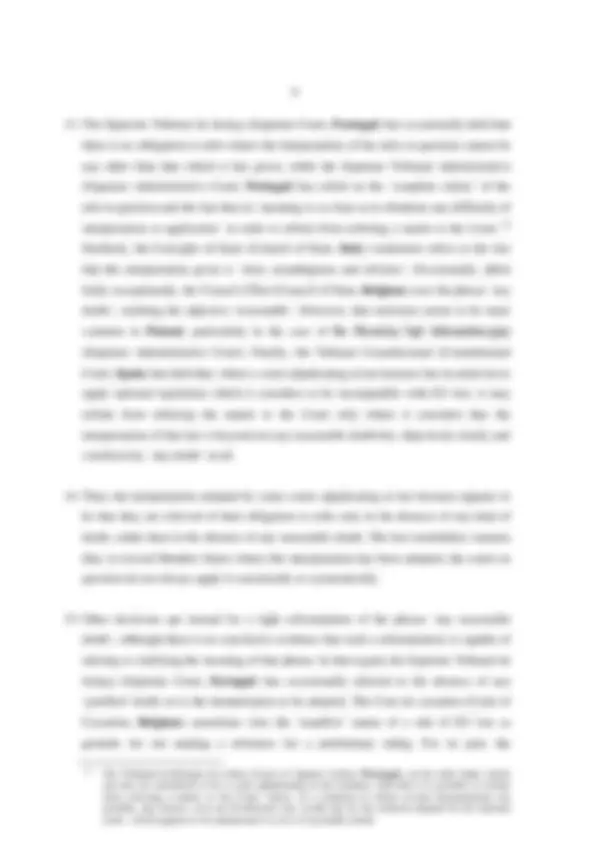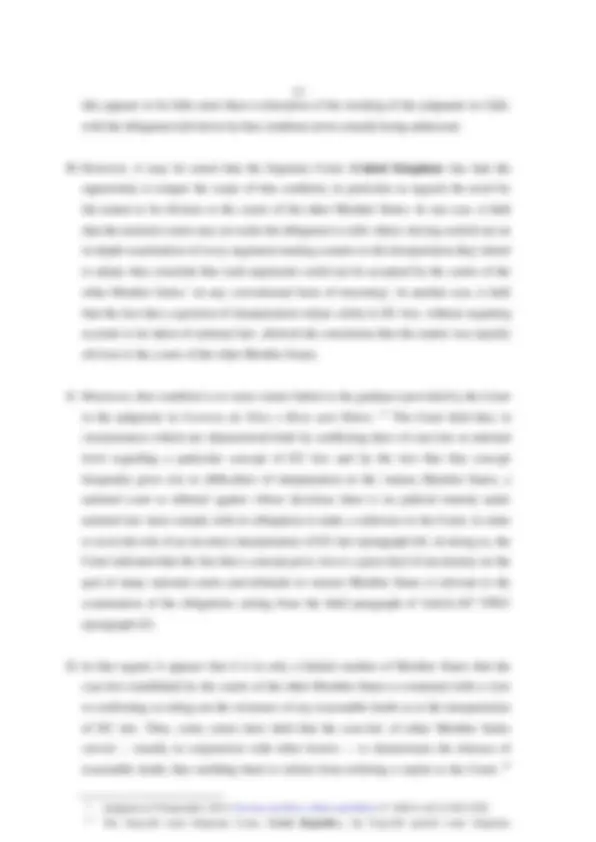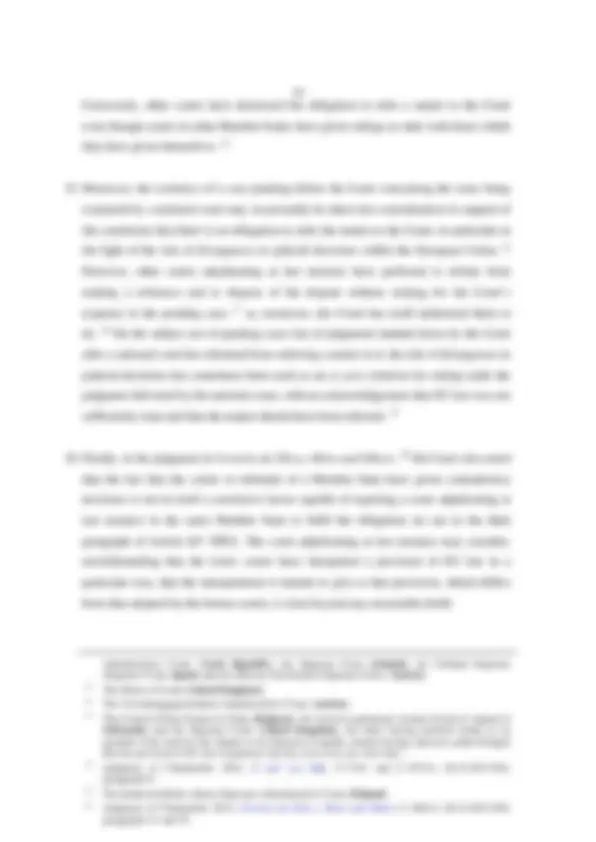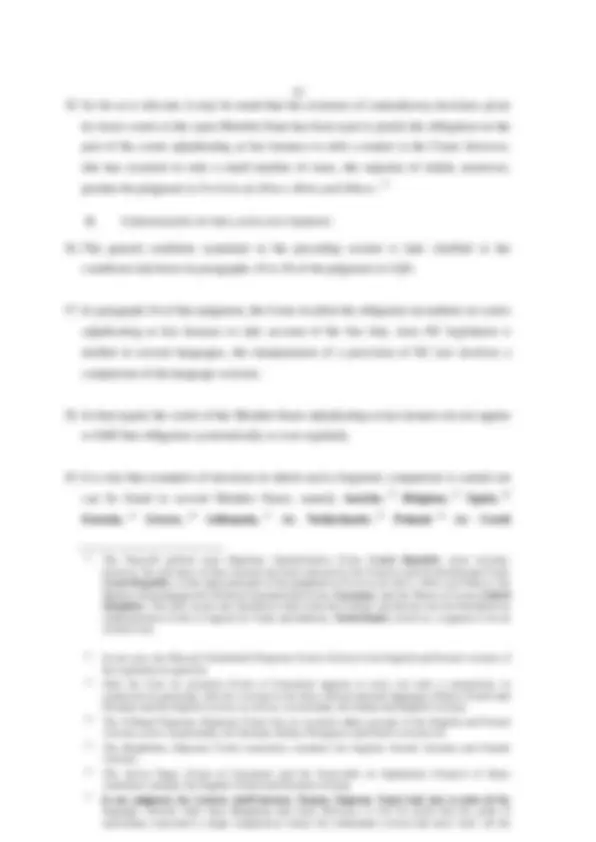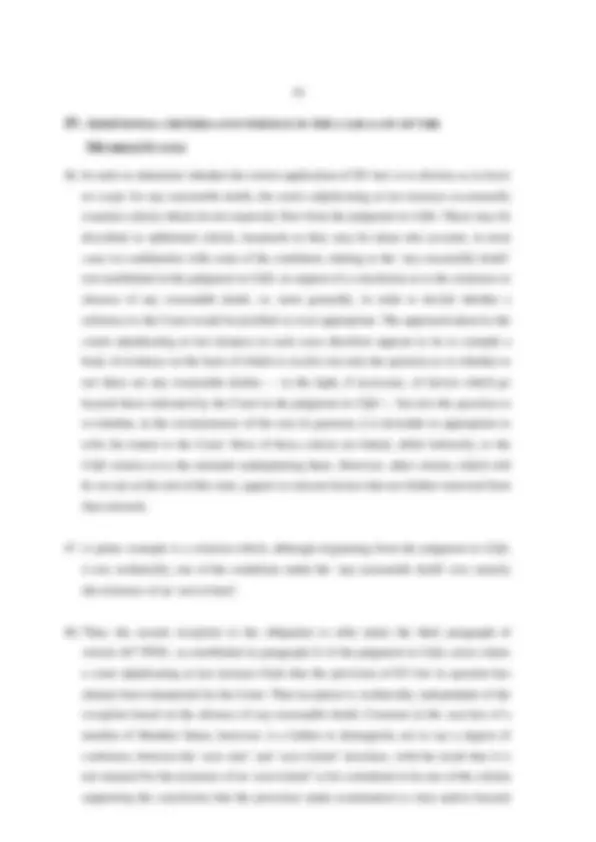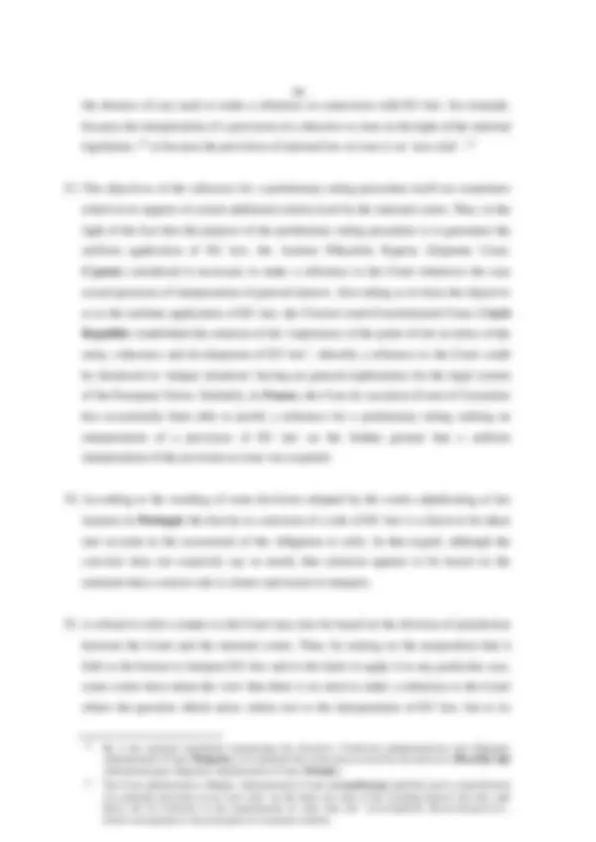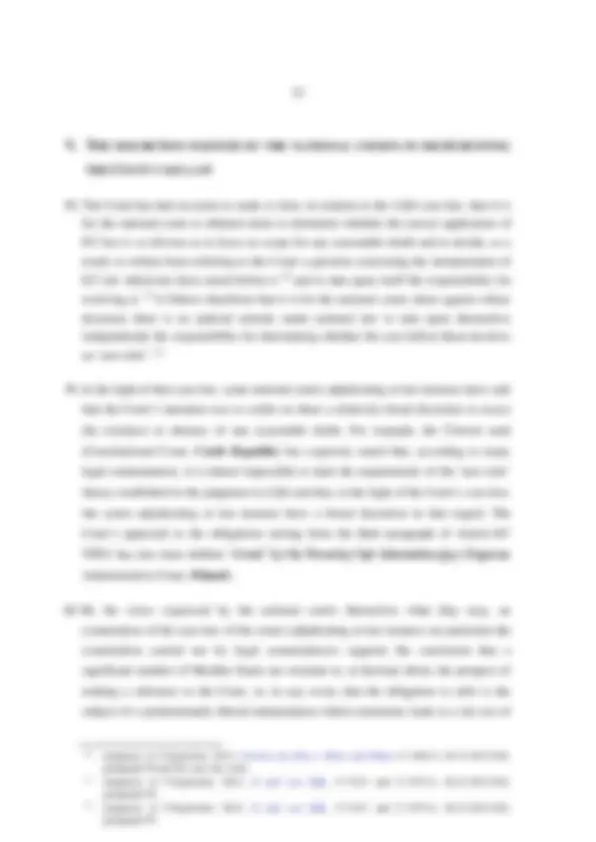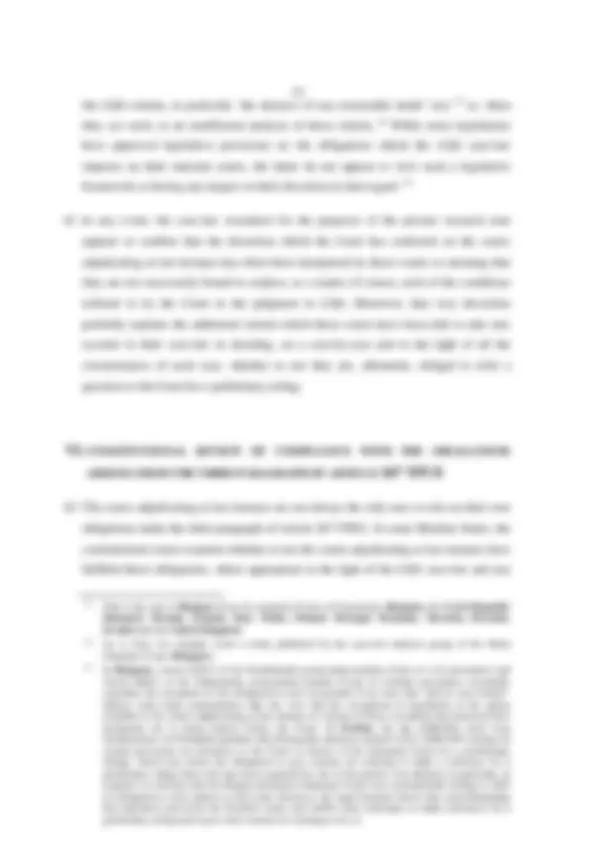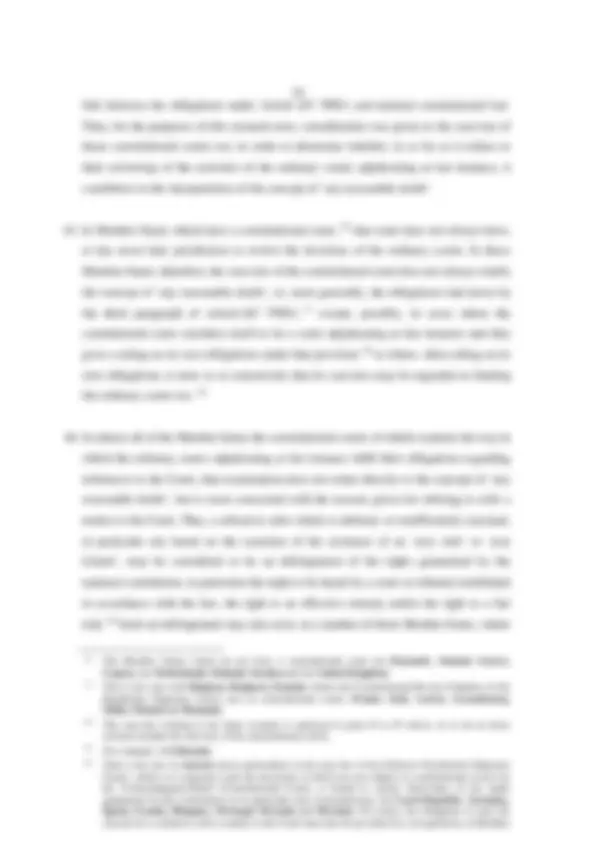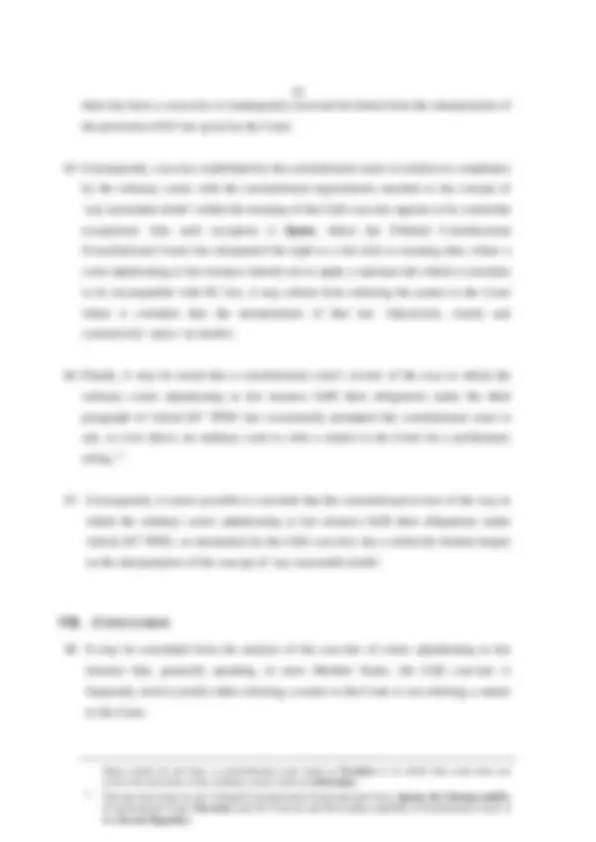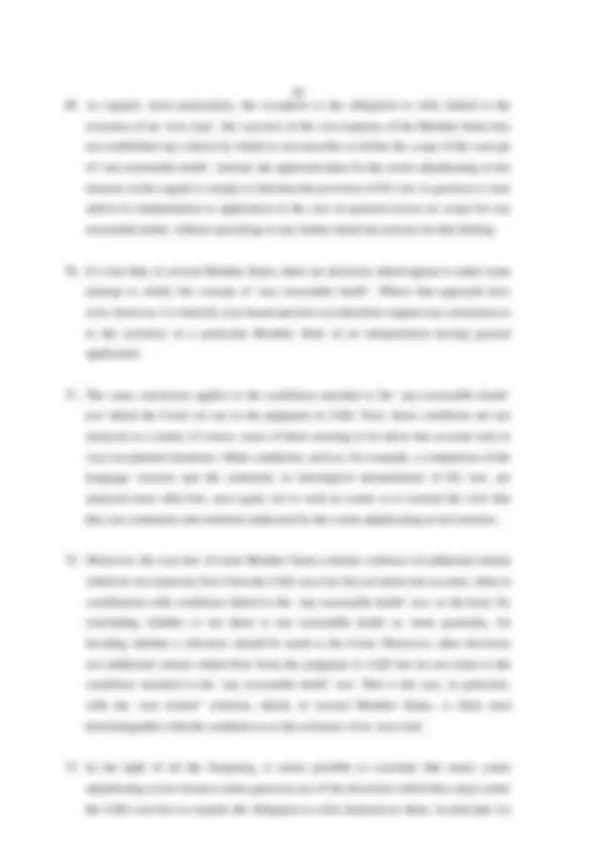Download National Courts' Duty to Refer EU Law Questions to ECJ: Analysis of Practices and more Study notes Law in PDF only on Docsity!
Directorate-General for Library, Research and Documentation
RESEARCH NOTE
Application of the Cilfit case-law by national courts or tribunals against whose decisions there is no judicial remedy under national law
[…]
Subject : Examination of how the Cilfit case-law (judgment of 6 October 1982, Cilfit and Others , 283/81, EU:C:1982:335) is applied by national courts or tribunals against whose decisions there is no judicial remedy under national law and, in particular, how they interpret the concept of ‘any reasonable doubt’.
[…]
May 2019 […]
SUMMARY
I. I NTRODUCTION
- The purpose of this research note is to answer the question of how the national courts or tribunals of the 28 Member States against whose decisions there is no judicial remedy under national law apply the ‘ Cilfit case-law’, which is to say that arising from the judgment of 6 October 1982, Cilfit and Others , 283/81 (‘the judgment in Cilfit ’) and, in particular, how they interpret the concept of ‘any reasonable doubt’.
- In that case-law, 1 the Court established several exceptions to the obligation to refer currently laid down in the third paragraph of Article 267 TFEU. 2 More particularly, it held that a court or tribunal against whose decisions there is no judicial remedy under national law is required, where a question of EU law is raised before it, to comply with its obligation to bring the matter before the Court, unless it has established: − that the question raised is irrelevant; or − that the provision of EU law in question has already been interpreted by the court; or − that the correct application of EU law is so obvious as to leave no scope for any reasonable doubt.
- In the more than 36 years that have passed since the judgment in Cilfit was delivered, the courts of the vast majority of Member States, in particular those against whose decisions there is no judicial remedy under national law (‘the courts adjudicating at last instance’ 3 ), have regularly and frequently referred to that judgment 4 in order to justify
(^1) See judgments of 6 October 1982, Cilfit and Others , 283/81, EU:C:1982:335, paragraph 21; of 9 September 2015, X and van Dijk , C-72/14 and C-197/14, EU:C:2015:564, paragraph 55; of 9 September 2015, Ferreira da Silva e Brito and Others , C-160/14, EU:C:2015:565, paragraph 38; and of 4 October 2018, Commission v France (advance payment of tax), C-416/17, EU:C:2018:811, paragraph 110. (^2) In accordance with which, ‘where any such [question requesting an interpretation or assessment of validity] is raised in a case pending before a court or tribunal of a Member State against whose decisions there is no judicial remedy under national law, that court or tribunal shall bring the matter before the Court’. It will be noted that the judgment in Cilfit was given in relation to one of the precursors to that provision, namely the third paragraph of Article 177 of the EEC Treaty. (^3) To quote the form of words used by the Court: see, for example, the judgment of 15 March 2017, Aquino , C-3/16, EU:C:2017:209, paragraph 34. (^4) Or, as the case may be, the criteria flowing from it, without actually referring to it expressly: this is
- In many Member States, the first two exceptions are employed far more frequently than the third. Nevertheless, this research note will concentrate on how the courts adjudicating at last instance apply the latter exception. In that regard, this note will set out the interpretation which those courts have had occasion to give to the concept of ‘any reasonable doubt’ (part II) and of the conditions attached to that test under the Cilfit case-law (part III). Next, it will identify some of the additional criteria employed by those courts, which is to say criteria that do not expressly flow from the judgment in Cilfit as conditions attached to the ‘any reasonable doubt’ test (part IV), and these too will provide a basis for offering some reflections on the discretion available to those courts in the implementation of the Cilfit case-law (part V). Finally, it will analyse the impact on the interpretation of the concept of ‘any reasonable doubt’ of the review by constitutional courts of the way in which ordinary courts adjudicating at last instance fulfil their obligations under Article 267 TFEU (part VI).
II. I NTERPRETATION OF THE CONCEPT OF ‘ANY REASONABLE DOUBT’
- As regards the third exception to the obligation to refer laid down in the third paragraph of Article 267 TFEU, whereby courts adjudicating at last instance are relieved of their obligation to bring a matter before the Court where they find that ‘the correct application of Community law is so obvious as to leave no scope for any reasonable doubt’, the courts in most Member States have struggled to come up with any precise or explicit criteria by which to circumscribe or define the scope of the concept of ‘any reasonable doubt’.
- Indeed, the vast majority of the legal systems are characterised by the absence of any structured, generic or principled approach to the reasonable doubt test. There is no generic definition or clear and unambiguous interpretation of the concept of ‘any reasonable doubt’ or of its counterpart, the ‘acte clair’. Rather, these concepts are applied on a case-by-case basis, not to say in a mechanical, simplistic or stereotypical fashion. It seems useful to note here that, although the national courts normally use the two concepts interchangeably, the case-law examined for the purposes of this research note shows that they refer to ‘acte clair’ far more often than they do to ‘any reasonable doubt’. That preference for the ‘acte clair’ concept, which is more concise and, therefore,
not necessarily in need of definition, may also go some way towards explaining why there is no definition of the concept of ‘any reasonable doubt’, which is less easy to clarify or pin down.
- Thus, the national courts will often simply find that they are not obliged to make a reference to the Court provided that the provision of EU law in question is clear and/or its interpretation or application in the case concerned leaves no scope for any reasonable doubt, 7 without for that matter specifying in any further detail the reasons for their finding to that effect, in particular with respect to the conditions laid down by the Court in the judgment in Cilfit (examined in part III below). In some Member States, such as Estonia and Malta , the concept of ‘any reasonable doubt’ is not even referred to in the case-law of the courts adjudicating at last instance. 8
- However, in several Member States, there is evidence, in some decisions at least, of an attempt to define or delimit the concept of ‘any reasonable doubt’, in particular by mitigating the impact of the ‘reasonableness’ of the doubt.
- In the United Kingdom , for example, the House of Lords and the Supreme Court, which replaced the House of Lords in 2009, have ruled out the need to make a reference to the Court where a particular interpretation is ‘clear beyond the bounds of reasonable argument’ or where it is ‘beyond reasonable dispute’. The Anotato Dikastirio Kyprou (Supreme Court, Cyprus ), referring to the UK case-law (applicable in Cyprus as a common-law system), was able to hold that a reference is justified where the question of EU law raised is not ‘free from doubt’). 9 Still within the context of common law, it is clear from certain judgments of the Supreme Court ( Ireland ) that a reference is no longer necessary where the application of EU law is so obvious as to leave no scope for doubt. (^7) Thus, in a not insignificant number of Member States, the judgment in Cilfit and, more particularly, the concepts of ‘any reasonable doubt’ and ‘acte clair’ are cited in many cases but as a basis for concluding, in most of them, that there is no obligation to refer: this is true in particular of Bulgaria (in particular the Varhoven administrativen sad (Supreme Administrative Court)), the Czech Republic (in particular, the Nejvyšší soud (Supreme Court) and the Nejvyšší správní soud (Supreme Administrative Court)), Ireland, Spain, Lithuania , Hungary , Portugal , Slovenia and Finland. (^8) While it does not necessarily mean that the principle underlying that concept is not applied in case- law, this absence of any reference (to the concept of ‘any reasonable doubt’) nevertheless makes it difficult to reach any clear conclusions as to the way in which that concept is interpreted and applied. (^9) Still with reference to the case-law of the Court of Appeal (England and Wales, United Kingdom ), the Anotato Dikastirio Kyprou (Supreme Court, Cyprus ) also ruled that the courts of first instance have a duty to make a reference to the Court unless they can resolve the question raised ‘with complete confidence’.
administrative chamber of the Riigikohus (Supreme Court, Estonia ) has invoked ‘serious’ doubts as grounds for its obligation to refer a matter to the Court; however, it has never used this as justification for a refusal to refer a matter to the Court.
- In France , the Conseil d’État (Council of State) and the Cour de cassation (Court of Cassation) frequently refer, among other turns of phrase, to the ‘serious difficulty’ of interpreting or assessing the validity of a rule of EU law, or the ‘serious controversy’ raised by the dispute. As regards ‘serious difficulty’, while those courts use that phrase as grounds for both referring a matter to the Court 11 and refusing to do so, 12 the latter scenario could be interpreted as going somewhat beyond the threshold of doubt behind the concept of ‘any reasonable doubt’ within the meaning of the Cilfit case-law.
- The degree of complexity of the question raised is sometimes taken into account too, although in support of different conclusions. While, for the House of Lords ( United Kingdom ), there is no ‘acte clair’ where the interpretation of a provision requires extensive reasoning, the Verwaltungsgerichtshof (Administrative Court, Austria ) has stated on several occasions that the need to resolve complex points of law does not in itself entail an obligation to refer a case to the Court.
- Unfortunately, the foregoing overview of national case-law does not appear to allow any firm conclusions to be drawn as to how to interpret the concept of ‘any reasonable doubt’ as such. It does, however, highlight the piecemeal nature of both the attempts to define or reformulate that concept and the use of any such definitions or reformulations. In any event, the courts adjudicating at last instance, whether using the ‘any reasonable doubt’ test or some other benchmark, be it similar or otherwise, often merely refer to it without specifying in any further detail the criteria against which it is to be applied on a case-by-case basis.
(^11) Almost always in the case of the Conseil d’État (Council of State) and along with other forms of words in the case of the Cour de cassation (Court of Cassation). (^12) Only in matters involving an assessment as to the validity of a provision of EU law, in the case of the Conseil d’État (Council of State), and more broadly in the case of the Cour de cassation (Court of Cassation).
III. THE CONDITIONS ATTACHED TO THE ‘ANY REASONABLE DOUBT’ TEST
ESTABLISHED BY THE JUDGMENT IN CILFIT
- It should be recalled that the exception to the obligation to refer on account of the absence of reasonable doubt is one that is framed by a number of conditions. The Court set out some of those conditions in the judgment in Cilfit itself when it noted, in the concluding paragraph of that judgment (paragraph 21), that ‘the existence of such a possibility must be assessed in the light of the specific characteristics of [EU] law, the particular difficulties to which its interpretation gives rise and the risk of divergences in judicial decisions within the [European Union]’.
- Those conditions were further spelled out in paragraphs 16 to 20 of that judgment.
- In the first place, the Court noted that, before concluding that the correct application of EU law is so obvious as to leave no scope for any reasonable doubt, ‘the national court or tribunal must be convinced that the matter is equally obvious to the courts of the other Member States and to the Court of Justice. Only if those conditions are satisfied, may the national court or tribunal refrain from submitting the question to the Court of Justice and take upon itself the responsibility for resolving it’ (paragraph 16).
- The Court went on to state that, ‘however, the existence of such a possibility must be assessed on the basis of the characteristic features of [EU] law and the particular difficulties to which its interpretation gives rise’ (paragraph 17).
- Thus, ‘to begin with, it must be borne in mind that [EU] legislation is drafted in several languages and that the different language versions are all equally authentic. An interpretation of a provision of [EU] law thus involves a comparison of the different language versions’ (paragraph 18).
- ‘It must also be borne in mind, even where the different language versions are entirely in accord with one another, that [EU] law uses terminology which is peculiar to it. Furthermore, it must be emphasised that legal concepts do not necessarily have the same meaning in [EU] law and in the law of the various Member States’ (paragraph 19).
- ‘Finally, every provision of [EU] law must be placed in its context and interpreted in the
this appears to be little more than a reiteration of the wording of the judgment in Cilfit , with the obligation laid down by that condition never actually being addressed.
- However, it may be noted that the Supreme Court ( United Kingdom ) has had the opportunity to temper the scope of that condition, in particular as regards the need for the matter to be obvious to the courts of the other Member States. In one case, it held that the national courts may set aside the obligation to refer where, having carried out an in-depth examination of every argument running counter to the interpretation they intend to adopt, they conclude that such arguments could not be accepted by the courts of the other Member States ‘on any conventional basis of reasoning’, In another case, it held that the fact that a question of interpretation relates solely to EU law, without requiring account to be taken of national law, allowed the conclusion that the matter was equally obvious to the courts of the other Member States.
- Moreover, that condition is to some extent linked to the guidance provided by the Court in the judgment in Ferreira da Silva e Brito and Others. 13 The Court held that, in circumstances which are characterised both by conflicting lines of case-law at national level regarding a particular concept of EU law and by the fact that that concept frequently gives rise to difficulties of interpretation in the various Member States, a national court or tribunal against whose decisions there is no judicial remedy under national law must comply with its obligation to make a reference to the Court, in order to avert the risk of an incorrect interpretation of EU law (paragraph 44). In doing so, the Court indicated that the fact that a concept gives rise to a great deal of uncertainty on the part of many national courts and tribunals in various Member States is relevant to the examination of the obligations arising from the third paragraph of Article 267 TFEU (paragraph 43).
- In that regard, it appears that it is in only a limited number of Member States that the case-law established by the courts of the other Member States is examined with a view to confirming or ruling out the existence of any reasonable doubt as to the interpretation of EU law. Thus, some courts have held that the case-law of other Member States served — usually in conjunction with other factors — to demonstrate the absence of reasonable doubt, thus enabling them to refrain from referring a matter to the Court. 14
(^13) Judgment of 9 September 2015, Ferreira da Silva e Brito and Others C-160/14, EU:C:2015:565. (^14) The Nejvyšší soud (Supreme Court, Czech Republic ), the Nejvyšší správní soud (Supreme
Conversely, other courts have dismissed the obligation to refer a matter to the Court even though courts in other Member States have given rulings at odds with those which they have given themselves. 15
- Moreover, the existence of a case pending before the Court concerning the issue being examined by a national court may occasionally be taken into consideration in support of the conclusion that there is an obligation to refer the matter to the Court, in particular in the light of the risk of divergences in judicial decisions within the European Union. 16 However, other courts adjudicating at last instance have preferred to refrain from making a reference and to dispose of the dispute without waiting for the Court’s response in the pending case, 17 as, moreover, the Court has itself authorised them to do. 18 On the subject not of pending cases but of judgments handed down by the Court after a national court has refrained from referring a matter to it, the risk of divergences in judicial decisions has sometimes been used as an ex post criterion for setting aside the judgment delivered by the national court, with an acknowledgement that EU law was not sufficiently clear and that the matter should have been referred. 19
- Finally, in the judgment in Ferreira da Silva e Brito and Others , 20 the Court also noted that the fact that the courts or tribunals of a Member State have given contradictory decisions is not in itself a conclusive factor capable of requiring a court adjudicating at last instance in the same Member State to fulfil the obligation set out in the third paragraph of Article 267 TFEU. The court adjudicating at last instance may consider, notwithstanding that the lower courts have interpreted a provision of EU law in a particular way, that the interpretation it intends to give to that provision, which differs from that adopted by the former courts, is clear beyond any reasonable doubt.
Administrative Court, Czech Republic ), the Supreme Court ( Ireland ), the Tribunal Supremo (Supreme Court, Spain ) and the Oberster Gerichtshof (Supreme Court, Austria ). (^15) The House of Lords ( United Kingdom ). (^16) The Verwaltungsgerichtshof (Administrative Court, Austria ). (^17) The Conseil d’État (Council of State, Belgium ), the Lietuvos apeliacinis teismas (Court of Appeal of Lithuania ) and the Supreme Court ( United Kingdom ), the latter having justified doing so on grounds of the need for the dispute to be disposed of rapidly, despite having expressly acknowledged that the provision of EU law in question was not, in its view, an ‘acte clair’. (^18) Judgment of 9 September 2015, X and van Dijk , C-72/14 and C-197/14, EU:C:2015:564, paragraph 61. (^19) The Korkein hallinto-oikeus (Supreme Administrative Court, Finland ). (^20) Judgment of 9 September 2015, Ferreira da Silva e Brito and Others C-160/14, EU:C:2015:565, paragraphs 41 and 42.
Republic , 30 the United Kingdom^31 and Slovenia. 32 However, even in those Member States, language versions do not appear to be compared as a matter of course and, where the courts adjudicating at last instance do carry out such a comparison, they usually do so in relation to a limited number of language versions, quite often English, French and German.
C. THE TERMINOLOGICAL PECULIARITIES OF EU LAW
- In paragraph 19 of the judgment in Cilfit , the Court noted that EU law uses terminology which is peculiar to it, with the result that it contains legal concepts which do not necessarily have the same meaning in the various national legal systems.
- None of the decisions consulted for the purposes of the present research note appear to address matters of terminology, at least not directly. These are analysed, at most, indirectly, as part of the comparison of language versions, in the form of a classification of the interpreted term as simple (Supreme Court ( United Kingdom )) or technical (Lietuvos Aukščiausiasis Teismas (Supreme Court, Lithuania )).
D. THE CONTEXTUAL, SCHEMATIC, TELEOLOGICAL AND DYNAMIC INTERPRETATION OF EU LAW
- Finally, in paragraph 20 of the judgment in Cilfit , the Court held that every provision of EU law must be placed in its context and interpreted in the light of the provisions of EU law as a whole, regard being had to the objectives thereof and to its state of evolution at the date on which the provision in question is to be applied.
- As with the other conditions, the case-law of the Member States does not routinely make
other versions had used ‘or’), which probably explains the large number of versions compared. As a general rule, it is more usually the English and French versions that are compared. (^28) There are examples from several Netherlands courts adjudicating at last instance. Such a comparison, which does not appear to be common, usually takes account of the English and French versions. (^29) This has been true of the ordinary (i.e. non-administrative) courts, such as the Sąd Najwyższy (Supreme Court), which have taken into account the English, French, German, Italian, and Czech versions, and the Sąd Apelacyjny Katowice (Court of Appeal, Katowice), which is the only court to say that it has taken account of all the language versions. (^30) The versions most commonly examined by the Nejvyšší správní soud (Supreme Administrative Court) and the Nejvyšší soud (Supreme Court) appear to be English, French, German, Slovakian and, where appropriate, Spanish. (^31) The Supreme Court has occasionally compared the French, German, Spanish and Dutch versions. (^32) The Vrhovno sodišče (Supreme Court) has compared, inter alia, the English, French and German versions.
reference to the interpretative methods set out in the judgment in Cilfit. Moreover, the courts adjudicating at last instance that use those methods do not do so as a matter of course.
- Thus, references are sometimes made to the objective and scheme of the act of EU law in question, 33 to the other provisions of that act and/or to other acts of EU law, 34 including the preparatory texts or other soft law measures, 35 and even to previous versions of the legislation at issue. 36
- However, and as is also true of the other conditions relating to ‘any reasonable doubt’ laid down in the judgment in Cilfit , the case-law analysed shows that the courts adjudicating at last instance do not use the interpretative methods referred to by the Court as a matter of course. At most, they rely on one or other of those methods, depending on the particular circumstances of each case, sometimes in combination with other criteria relating to the ‘any reasonable doubt’ test established in the judgment in Cilfit , or even in conjunction with additional, more extensive criteria.
(^33) This is true of the Cour de cassation (Court of Cassation, Belgium ); the Tribunal Supremo (Supreme Court, Spain ); the Conseil d’État (Council of State, France ); the Areios Pagos (Court of Cassation, Greece ) and the Symvoulio tis Epikrateias (Council of State, Greece ); the Lietuvos Aukščiausiasis Teismas (Supreme Court, Lithuania ); several Netherlands courts adjudicating at last instance; the Vrhovno sodišče (Supreme Court, Slovenia ); in the Czech Republic , the Nejvyšší soud (Supreme Court) and the Nejvyšší správní soud (Supreme Administrative Court); and, in Romania , the Curtea de Apel (Court of Appeal), Bucharest. (^34) An approach taken by the Cour constitutionnelle (Constitutional Court) and the Cour de cassation (Court of Cassation, Belgium ), the Riigikohus (Supreme Court, Estonia ), the Latvijas Republikas Satversmes tiesa (Constitutional Court, Latvia ) and the Areios Pagos (Court of Cassation, Greece ). (^35) This is true, for example of the Cour constitutionnelle (Constitutional Court) and the Cour de cassation (Court of Cassation, Belgium ), when referring, respectively, to the calculation methods established by the European Banking Authority and in the Virgós-Schmit report; the Tribunal Supremo (Supreme Court, Spain ), when referring to a Commission report on the implementation of a framework decision; the Supreme Court ( Ireland ), when citing the Schlosser report; the Najvyšší súd Slovenskej republiky (Supreme Court of the Slovak Republic ), when referring to the Commission’s evaluation of the transposition of the directive in question in Slovakian law; the Nejvyšší správní soud (Supreme Administrative Court, Czech Republic ), when citing the explanatory notes of the Commission and the World Customs Organisation on the combined nomenclature; and the Vrhovno sodišče (Supreme Court, Slovenia ), when referring to a Commission communication. (^36) The Raad van State (Council of State, Netherlands ) and the Nejvyšší správní soud (Supreme Administrative Court, Czech Republic ).
any reasonable doubt. 37
- Some courts, like the Supreme Court ( United Kingdom ) and the Supreme Court ( Ireland ), have also been known to rest their conclusion as to the absence of any reasonable doubt on the fact that, while the interpretation adopted is not confirmed by the case-law of the Court, it is not called into question by it either, that is to say in the absence of any case-law of the Court that casts doubt on that interpretation.
- Another factor taken into account by some courts adjudicating at last instance is whether the interpretation of EU law which they intend to adopt enjoys unanimous support within the panel of judges or the court in question. Thus, while some courts consider that the absence of such unanimity prevents them, in principle, from taking the view that there is no reasonable doubt and therefore obliges them to refer a question to the Court for a preliminary ruling, 38 these are outnumbered by those who have dismissed the obligation to refer notwithstanding that the intended interpretation was not unanimous within the panel of judges or the court in question. 39
- Moreover, some national courts justify the obligation to refer a matter to the Court by reference to works of legal literature, both national and international, that support the conclusion that there are doubts as to the interpretation of the provision in question. 40 The absence of any reasonable doubt has also been established on the basis of the opinions of expert witnesses, invited by the court in question, who have concluded that the provisions of EU law at issue are clear and explicit. 41
- Somewhat less commonly, it is the national legislation which is relied on in support of
(^37) That is the case in Belgium , Denmark , Ireland , Greece (Areios Pagos (Court of Cassation) and Symvoulio tis Epikrateias (Council of State)), Spain (Tribunal Supremo (Supreme Court)), Italy , Latvia (Latvijas Republikas Satversmes tiesa (Constitutional Court)), Hungary, Poland (Sąd Najwyższy (Supreme Court)), Romania (Curtea de Apel (Court of Appeal), Cluj), Slovenia and Finland. (^38) For example, in Greece (Areios Pagos (Court of Cassation) and Symvoulio tis Epikrateias (Council of State)) and the United Kingdom (House of Lords, later Supreme Court). While it is true that some decisions in those two Member States have done the opposite, courts taking this approach appear to be in the minority. (^39) For example, in the Czech Republic (Nejvyšší soud (Supreme Court)), Estonia, Spain (Tribunal Supremo (Supreme Court)), Cyprus and Sweden (Högsta domstolen (Supreme Court)). (^40) The Nejvyšší soud (Supreme Court, Czech Republic ), the Bundesverfassungsgericht (Federal Constitutional Court, Germany ), the Hoge Raad der Nederlanden (Supreme Court of the Netherlands ) and the Verfassungsgerichtshof (Constitutional Court, Austria ). (^41) Latvijas Republikas Satversmes tiesa (Constitutional Court, Latvia ).
the absence of any need to make a reference in connection with EU law: for example, because the interpretation of a provision of a directive is clear in the light of the national legislation, 42 or because the provision of national law at issue is an ‘acte clair’. 43
- The objectives of the reference for a preliminary ruling procedure itself are sometimes relied on in support of certain additional criteria used by the national courts. Thus, in the light of the fact that the purpose of the preliminary ruling procedure is to guarantee the uniform application of EU law, the Anotato Dikastirio Kyprou (Supreme Court, Cyprus ) considered it necessary to make a reference to the Court whenever the case raised questions of interpretation of general interest. Also taking as its basis the objective as to the uniform application of EU law, the Ústavní soud (Constitutional Court, Czech Republic ) established the criterion of the ‘importance of the point of law in terms of the unity, coherence and development of EU law’, whereby a reference to the Court could be dismissed in ‘unique situations’ having no general implications for the legal system of the European Union. Similarly, in France , the Cour de cassation (Court of Cassation) has occasionally been able to justify a reference for a preliminary ruling seeking an interpretation of a provision of EU law on the further ground that a uniform interpretation of the provision at issue was required.
- According to the wording of some decisions adopted by the courts adjudicating at last instance in Portugal , the brevity or concision of a rule of EU law is a factor to be taken into account in the assessment of the obligation to refer. In that regard, although the case-law does not expressly say as much, that criterion appears to be based on the rationale that a concise rule is clearer and easier to interpret.
- A refusal to refer a matter to the Court may also be based on the division of jurisdiction between the Court and the national courts. Thus, by relying on the proposition that it falls to the former to interpret EU law and to the latter to apply it in any particular case, some courts have taken the view that there is no need to make a reference to the Court where the question which arises relates not to the interpretation of EU law, but to its
(^42) Be it the national legislation transposing the directive (Varhoven administrativen sad (Supreme Administrative Court, Bulgaria )) or a national law in the area covered by the directive (Naczelny Sąd Administracyjny (Supreme Administrative Court, Poland )). (^43) The Cour administrative (Higher Administrative Court, Luxembourg ) justified such a classification of a national provision as an ‘acte clair’ on the basis not only of the wording thereof, but also, and above all, by reference to the requirements of, inter alia, the ‘ wirtschaftliche Betrachtungsweise ’, which corresponds to the principles of economic realism.





